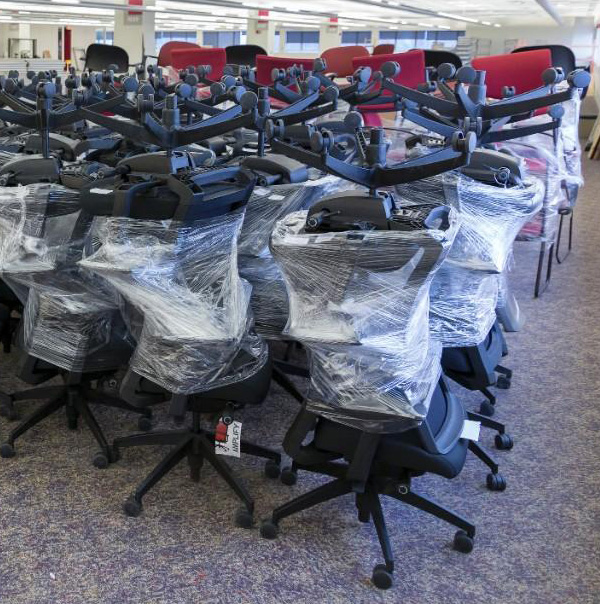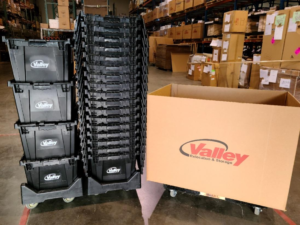Moving your business to a new location can be an exciting opportunity for growth and expansion, but it can also be stressful and overwhelming.
From packing and organizing to deciding on the move-in day, there are many tasks that need to be completed to ensure a successful transition. That’s why creating a moving checklist is essential for any commercial move. It helps you stay organized, keep track of tasks, and ensure nothing is overlooked.
Valley Relocation has been California’s leading commercial moving company for nearly 40 years, and we help with everything from planning to the actual moving.
In this blog, we’ll take you through the step-by-step process of creating a comprehensive moving checklist for your commercial move. By following our guide, you can make your commercial move a smooth and stress-free experience. So, let’s create a moving checklist that works for you!
Why Do You Need A Moving Checklist?
A moving checklist is crucial for any commercial move as it helps streamline the process and ensure nothing is forgotten or overlooked. It provides a detailed roadmap for the move, outlining all the tasks that need to be accomplished and establishing a timeline for completion.
A moving checklist helps ensure that all aspects of the move are accounted for, from decluttering and packing to notifying relevant parties and arranging utilities and services.
By creating a checklist, businesses can stay organized and focused throughout the move, making the process smoother and less stressful for everyone involved.
How To Create A Moving Checklist
A moving checklist is necessary for a smooth and successful move, but how do you create one? Here’s an outline for you to follow.
1. Start Early
Starting early is one of the most crucial aspects of creating a moving checklist. The earlier you begin planning, the more time you have to handle unexpected situations.
The first thing you should do is identify your moving date and establish a timeline for all the tasks that need to be completed before the move. This includes researching moving companies, obtaining quotes, decluttering, and packing.
You should also communicate the move with all relevant parties, including employees, customers, and vendors, to ensure everyone knows about the upcoming transition.
By starting early and creating a detailed plan, you can avoid last-minute rush and stress and make the move as smooth as possible.
2. Set A Budget
Setting a budget is essential in creating a moving checklist, especially if you’re working with commercial moving services. It helps ensure you have adequate funds to cover all aspects of the move, including hiring a moving company, packing materials, and any additional expenses.
To set a budget, you should research the costs associated with the move, including moving company fees, insurance, and storage expenses. Once you have a clear idea of the costs, you can allocate funds accordingly and make any necessary adjustments to your budget.
It’s also important to factor in any unexpected expenses that may arise during the move. By setting a realistic budget and monitoring your expenses throughout the process, you can stay within your financial means and avoid any financial surprises.
If it’s your first time with commercial moving, you can ask professional movers to do a site walk-through and provide a cost estimate. Take Valley Relocation, for instance. We do an in-person or virtual site survey and provide free cost estimates. This helps in creating accurate budgets and allocating funds to your move.
3. Hire A Commercial Moving Company
Hiring a reputable commercial moving company is crucial to the success of your move, and it’s essential to research different companies before making a final decision.
Start by asking for recommendations from other businesses or researching online. Once you’ve shortlisted a few companies, request quotes and compare their services and pricing. You should also ask about the company’s experience, licensing, and insurance to ensure they are qualified to handle your move.
Before hiring a moving company, make sure to read reviews and testimonials from previous customers to get an idea of their reliability and professionalism. By hiring the right moving company, you can rest assured that your move will be handled efficiently and with minimal stress.
4. Create an Inventory List
Creating a detailed inventory list is an essential component of a moving checklist, as it helps to keep track of all the items that need to be moved. It’s important to make a comprehensive list of all items, including furniture, equipment, and supplies, and group them by category or department.
You should also identify any items that require special packing or handling and make sure to label them accordingly. The inventory list should be regularly updated as you progress through the moving process, and you should ensure that it’s easily accessible to all parties involved in the move.
An inventory list ensures you can avoid losing or misplacing any items during the move, making the process smoother and less stressful.
5. Declutter and Dispose of Unnecessary Items
Decluttering and disposing of unnecessary items is an important step in the moving process, as it helps to reduce the overall volume of items that need to be moved. It’s important to include this in your moving checklist.
Start by assessing each item and determining whether it’s necessary or can be disposed of. This can include outdated equipment, unused supplies, or furniture you no longer need.
You can donate or sell items still in good condition or dispose of them if they’re no longer usable. Decluttering and disposing of unnecessary items reduces the cost and time associated with the move and start fresh in your new location.
It’s important to involve employees in the decluttering process to ensure everyone is on board and that nothing important is accidentally discarded.
6. Notify Relevant Parties
It’s crucial to notify relevant parties of your move as soon as possible to avoid any miscommunication or delays. This includes customers, vendors, suppliers, and employees.
Make a list of all the parties that need to be informed and create a communication plan to ensure everyone is notified promptly and efficiently. You can send out an email or newsletter, post on social media, or even physically mail your contacts to inform them about the upcoming move.
This part of the moving checklist will remind you to keep everyone informed and ensure there are no misunderstandings or disruptions to your business operations.
7. Arrange for Utilities and Services
Arranging for utilities and services is an important step in the moving checklist to ensure you have all the necessary amenities in your new location. This includes electricity, water, internet, phone lines, and any other services required for your business.
Make a list of all the utilities and services that need to be set up, and contact the providers to make arrangements. You should also ensure the services are set up before your move-in date to avoid delays or interruptions.
Arranging for utilities and services in advance on your moving checklist will ensure that your business operations continue smoothly in your new location.
8. Plan for Packing and Labeling
Planning for packing and labeling is a crucial step in the moving checklist, as it ensures that all items are packed safely and efficiently.
Create a packing plan that includes the necessary materials and equipment, such as boxes, tape, labels, and packing foam. You should also determine the order in which items will be packed, starting with non-essential items and working toward essential items.
Label all boxes clearly with the contents and the destination room to ensure they are placed correctly during the move-in process.
By planning for packing and labeling, you can ensure that all items are packed safely and efficiently, making the move-in process smoother and less stressful.
9. Coordinate With Relevant Parties
Coordinating with everyone involved in the move is an important step in the moving checklist, as it ensures that everything runs smoothly on the day of the move.
Start by creating a plan for the move-in day, including the schedule, the people responsible for coordinating the move, and any necessary equipment or tools. You should also ensure that all relevant parties know the move-in day and have the necessary information to access the new location.
On the day of the move, ensure that everything is packed and labeled correctly and that all parties involved know their responsibilities. Through this, you can ensure that everything runs smoothly and that there are no delays or disruptions.
10. Plan for Post-Move Tasks
Planning for post-move tasks is an important step in the moving checklist, as it ensures that everything is settled in your new location. This includes unpacking, setting up equipment and furniture, and any necessary repairs or maintenance.
Create a post-move plan with a timeline for completing these tasks, and allocate responsibilities to the relevant parties. You should also ensure that all necessary repairs or maintenance are completed before your business operations commence in your new location.
Planning for post-move tasks ensures that everything is settled and ready for business operations to continue as usual.
11. Evaluate Insurance Needs
It’s essential to assess your insurance needs before the move, as it can help you mitigate any potential losses or damages that may occur during the transition.
Contact your insurance provider and inquire about the coverage options available for your commercial move. Find out if you’re covered for the duration of the move or if you need to purchase additional insurance for specific items, such as valuable equipment or furniture.
Commercial business movers provide various insurance policies as well. Consult with your movers on what kind of insurance is right for you.
Once you understand your insurance coverage, you can factor it into your budget and make any necessary arrangements to protect your assets.
12. Establish Communication Channels
Effective communication is critical to the success of any commercial move. Establish communication channels with your team, commercial moving company, and other relevant parties involved in the move.
Set up regular check-ins and updates to ensure everyone is on the same page and aware of any changes or updates to the moving plan.
Create a contact list that includes key contacts for the commercial moving company, utility providers, and any other relevant parties to ensure you can reach them quickly in case of any issues.
13. Incorporate Contingency Planning
Despite your best efforts, unexpected events can happen during a commercial move. That’s why it’s essential to have contingency plans in place. Consider weather conditions, traffic, and other potential roadblocks that may impact your moving timeline.
Plan for any potential issues and think of backup solutions to mitigate delays or disruptions. It’s better to be over-prepared than caught off-guard, so take the time to think through any potential contingencies and create a plan to address them proactively.
Let Us Make Your Commercial Relocation A Success!
Valley Relocation is a top-notch choice for businesses looking for local commercial moving services in California. Boasting nearly 40 years of experience, we have a proven track record of providing exceptional commercial moving services across major cities in California, such as San Francisco, Sacramento, and San Jose.
Not only do we specialize in commercial relocation services, but we also offer temporary commercial storage solutions with flexible options to meet your specific needs.
We understand that moving your business can be a daunting task, which is why we go the extra mile to make the process easier for you. We offer helpful moving tips and information on our blog to help guide you through the moving process.
Don’t hesitate to get in touch with us to schedule your move, and let our team of professionals handle the entire process with ease and professionalism.
Contact Valley Relocation today and experience top-quality commercial moving services.







